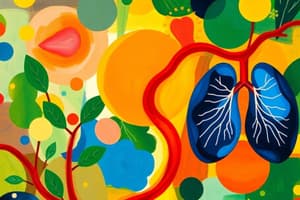Podcast
Questions and Answers
What is the main purpose of cellular respiration?
What is the main purpose of cellular respiration?
In which stage of cellular respiration is pyruvate produced?
In which stage of cellular respiration is pyruvate produced?
What byproducts are produced during aerobic respiration?
What byproducts are produced during aerobic respiration?
Which process directly uses light energy to produce ATP?
Which process directly uses light energy to produce ATP?
Signup and view all the answers
Which statement accurately describes the relationship between cellular respiration and photosynthesis?
Which statement accurately describes the relationship between cellular respiration and photosynthesis?
Signup and view all the answers
What is the role of the Calvin Cycle in photosynthesis?
What is the role of the Calvin Cycle in photosynthesis?
Signup and view all the answers
What is produced during the Krebs Cycle?
What is produced during the Krebs Cycle?
Signup and view all the answers
Which type of respiration occurs in the absence of oxygen?
Which type of respiration occurs in the absence of oxygen?
Signup and view all the answers
Study Notes
Life Process Study Notes
Cellular Respiration
- Definition: Process by which cells convert glucose and oxygen into energy (ATP), releasing carbon dioxide and water as byproducts.
-
Stages:
-
Glycolysis:
- Occurs in the cytoplasm.
- Glucose is broken down into pyruvate, producing a small amount of ATP and NADH.
-
Krebs Cycle (Citric Acid Cycle):
- Takes place in the mitochondria.
- Pyruvate is further broken down, producing NADH, FADH2, ATP, and CO2.
-
Electron Transport Chain (ETC):
- Occurs in the inner mitochondrial membrane.
- Electrons from NADH and FADH2 are transferred through proteins, leading to the production of a large amount of ATP and water.
-
Glycolysis:
Photosynthesis
- Definition: Process by which green plants, algae, and some bacteria convert light energy into chemical energy in the form of glucose.
- Equation: 6CO2 + 6H2O + light energy → C6H12O6 + 6O2
-
Stages:
-
Light-dependent Reactions:
- Occur in the thylakoid membranes of chloroplasts.
- Capture light energy, producing ATP and NADPH, and releasing oxygen as a byproduct.
-
Calvin Cycle (Light-independent Reactions):
- Takes place in the stroma of chloroplasts.
- Uses ATP and NADPH to convert CO2 into glucose.
-
Light-dependent Reactions:
Respiration
- Definition: Biological process through which organisms exchange gases (O2 intake and CO2 expulsion).
-
Types of Respiration:
-
Aerobic Respiration:
- Requires oxygen.
- Produces more ATP compared to anaerobic respiration.
-
Anaerobic Respiration:
- Occurs in the absence of oxygen.
- Produces less ATP and results in byproducts like lactic acid (in animals) or ethanol and CO2 (in yeast).
-
Aerobic Respiration:
Relationships
-
Cellular Respiration and Photosynthesis:
- Photosynthesis generates glucose and oxygen, which are essential for cellular respiration.
- Cellular respiration produces carbon dioxide and water, which are used in photosynthesis.
- Both processes are critical for energy flow in ecosystems and maintain atmospheric balance of oxygen and carbon dioxide.
Cellular Respiration
- A process that converts glucose and oxygen into energy (ATP) within cells.
- Releases carbon dioxide and water as byproducts.
- Involves three main stages: glycolysis, Krebs cycle, and electron transport chain.
Glycolysis
- Occurs in the cytoplasm of cells.
- Breaks down glucose into pyruvate, producing a small amount of ATP and NADH.
Krebs Cycle (Citric Acid Cycle)
- Takes place in the mitochondria of cells.
- Further breaks down pyruvate, producing NADH, FADH2, ATP, and CO2.
Electron Transport Chain (ETC)
- Occurs in the inner mitochondrial membrane.
- Electrons from NADH and FADH2 are transferred through proteins, generating a significant amount of ATP and water as the final product.
Photosynthesis
- Process used by plants, algae, and some bacteria to convert light energy into chemical energy in the form of glucose.
- Equation: 6CO2 + 6H2O + light energy → C6H12O6 + 6O2
- Involves two main stages: light-dependent reactions and Calvin cycle (light-independent reactions).
Light-dependent Reactions
- Occur in the thylakoid membranes of chloroplasts.
- Capture light energy, producing ATP and NADPH, and releasing oxygen as a byproduct.
Calvin Cycle (Light-independent Reactions)
- Takes place in the stroma of chloroplasts.
- Uses ATP and NADPH to convert CO2 into glucose.
Respiration
- Biological process through which organisms exchange gases: oxygen intake and carbon dioxide expulsion.
- Two main types: aerobic respiration and anaerobic respiration.
Aerobic Respiration
- Requires oxygen to function.
- Produces more ATP compared to anaerobic respiration.
Anaerobic Respiration
- Occurs in the absence of oxygen.
- Produces less ATP and results in byproducts like lactic acid (in animals) or ethanol and CO2 (in yeast).
Relationships
- Cellular respiration and photosynthesis are interconnected processes that maintain balance in ecosystems.
- Photosynthesis creates glucose and oxygen, essential for cellular respiration.
- Cellular respiration produces carbon dioxide and water, used in photosynthesis.
- These processes are critical for energy flow in ecosystems and maintain the balance of oxygen and carbon dioxide in the atmosphere.
Studying That Suits You
Use AI to generate personalized quizzes and flashcards to suit your learning preferences.
Description
Explore the key concepts of cellular respiration and photosynthesis in this quiz. Discover the stages of energy production in cells, from glycolysis to electron transport, as well as how plants convert light into chemical energy. Test your knowledge on these essential biological processes.




